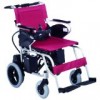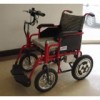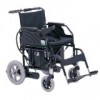生物工程学报 Chin J Biotech 2008, March 25; 24(3): 401-408
journals.im.ac.cn Chinese Journal of Biotechnology ISSN 1000-3061
cjb@im.ac.cn . 2008 Institute of Microbiology, CAS & CSM, All rights reserved
陈祥, 刘静, 高崧, 潘志明, 焦新安, 刘秀梵
扬州大学 农业部畜禽传染病学重点开放实验室/江苏省人兽共患病学重点实验室, 扬州 225009
摘 要: 通过SSH 和SCOTS 研究, 铁系统(Iro)和温度敏感性血凝素(Tsh)在禽病原性大肠杆菌(APEC)的感染中可能发挥重要作用。基因检测发现, 在243 个禽源大肠杆菌分离株中, 有205 株为iro+菌株, 其中高、中度和低致病株分别为89.8%(184/205)、8.8%(18/205)和1.5%(3/205); 有167 株为tsh+菌株, 高、中度、低致病株分别为87.4%(146/167)、12.6%(21/167)和0%(0/167), 结果显示iro+或tsh+株大多数为高致病株。为了确定iro 和tsh 基因在APEC 致病力中的作用, 以APEC E037 株为基础, 通过自杀性载体分别构建了iro 和tsh 基因缺失突变株E037(Δiro)、E037(Δtsh)和E037(ΔiroΔtsh)。动物感染性试验表明, 突变株在鸡体内的繁殖能力和致病性均明显下降, 但两个基因的协同致病作用不显著。进一步证实Iro 和Tsh 为APEC 重要的致病因子。
关键词: 禽病原性大肠杆菌, 铁系统, 温度敏感性血凝素, 缺失突变株
Construction and Characterization of Avian Pathogenic Escherichia coli Mutants with iro and/or tsh Gene Mutation
Xiang Chen, Jing Liu, Song Gao, Zhiming Pan, Xin’an Jiao and Xiufan Liu
Animal Infectious Disease Laboratory of Ministry of Agriculture, Jiangsu Key Laboratory of Zoonoses, Yangzhou University, Yangzhou 225009, China
Abstract: Iro system and temperature-sensitive hemagglutinin (Tsh) genes were identified by suppression subtractive hybridization (SSH) and selective capture of transcribed sequences (SCOTS). To get more insights in the distribution and the occurrence of the iroC and tsh genes, we examined 243 avian E. coli strains for the presences of the these genes. Among 243 avian E. coli isolates, iroC gene was present in 84.4% strains (205/243). Of the 205 iroC-positive isolates, iroC gene was found in 184 (89.8%), 18(8.8%) and 3 (1.5%) isolates with high, intermediate and low pathogenicity, respectively. Of the 167 tsh-positive isolates, tsh gene was detected in 146 (87.4%), 21 (12.6%) and 0 (0%) isolates with high, intermediate and low pathogenicity, respectively. Among tsh-positive isolates, 89.5 to 100% of the highly pathogenic isolates of O1, O2 or O78 serogroups had the tsh gene, while 53.3% of the highly pathogenic isolates of non-O1, O2 and O78 serogroups had the tsh gene (P<0.01). Suicide vectors for deletion of the iroBCDEN or tsh genes were constructed as follows. The 715-bp fragments of iroB and 603-bp fragment of the iroN were generated by PCR respectively. Both of these two fragments together with EGFP gene were cloned into pUC18, termed pUC18-iroBNEGFP. A resultant suicide vector containing the iroB-EGFP-iroN fragment was obtained and named pMEG375-iroBNEGFP. Similarly, both of the 685-bp fragment of tshF and the 692-bp fragment of the tshR together with gentamycin gene were cloned into pUC18, resulting in pUC18-tshFRGm. A resultant suicide vector containing the tshF-Gm-tshR fragment was named pMEG375-tshFRGm. Mutant derivatives of strain E037 were generated by allelic replacements and were named E037(Δiro), E037(Δtsh) and E037(ΔiroΔtsh). The 50% lethal dose (LD50) of E037, E037(Δiro), E037(Δtsh) and E037(ΔiroΔtsh) in commercial day-old chickens experimentally inoculated via intratrachea were determined to be 105.6, 108.4, 109.0 and 109.5CFU, respectively. In the chicken challenging model, the mutants were tested to determine the individual role of this system for virulence and persistence in chickens. The result suggested that Iro system and Tsh were important in the pathogenicity of APEC.
Keywords: avian pathogenic Escherichia coli, iro system, temperature-sensitive hemagglutinin, mutant
禽大肠杆菌病(Avian colibacillosis)指由禽病原性大肠杆菌(Avian pathogenic Escherichia coli, APEC)所引起的传染病, 常引起局部或全身感染, 是鸡、鸭、鹅和火鸡等禽类的一种常见传染病。部分APEC菌株基因组与人的尿道致病性大肠杆菌(Uropathogenic E. coli, UPEC)非常相似, 提示部分APEC 菌株可能是一种食源性病原微生物及人泌尿系统感染UPEC 的来源, 显示其重要的公共卫生意义[1]。禽大肠杆菌血清型复杂多样, 世界许多地方都开展了禽病原性大肠杆菌血清型的调查工作, O78 为最优势的血清型[2], 近年来从我国分离的1351 株禽源大肠杆菌中, O78 血清型有271 株, 占分离菌株的20.1%, 为最主要的血清型[3]。禽大肠杆菌病致病机理复杂, 许多毒力因子功能尚不清楚, 本文以我国分离的APEC E037 株(O78血清型)获得的SSH 差异片段和SCOTS 体内转录序列为基础[4,5], 选取铁系统(Iro system, Iro)和温度敏感性血凝素(Temperature-sensitive hemagglutinin,Tsh)为研究对象, 分别构建了iro 和tsh 基因缺失突变E037(Δiro)、E037(Δtsh)和E037(ΔiroΔtsh), 并初步研究了突变株的致病性, 为深入研究iro 和tsh基因的功能及研制肠道外感染大肠杆菌基因工程疫苗提供了有益尝试。
全文下载:禽病原性大肠杆菌iro 和tsh 基因缺失株的构建
更多全文请查看链接:http://journals.im.ac.cn
声明:本文由《生物工程学报》授权生物谷 www.bioon.com 网站发布,如需转载请直接与中国科学院微生物研究所期刊联合编辑部联系并支付相应费用,未经授权不得转载,若转载将付相应的法律责任。







